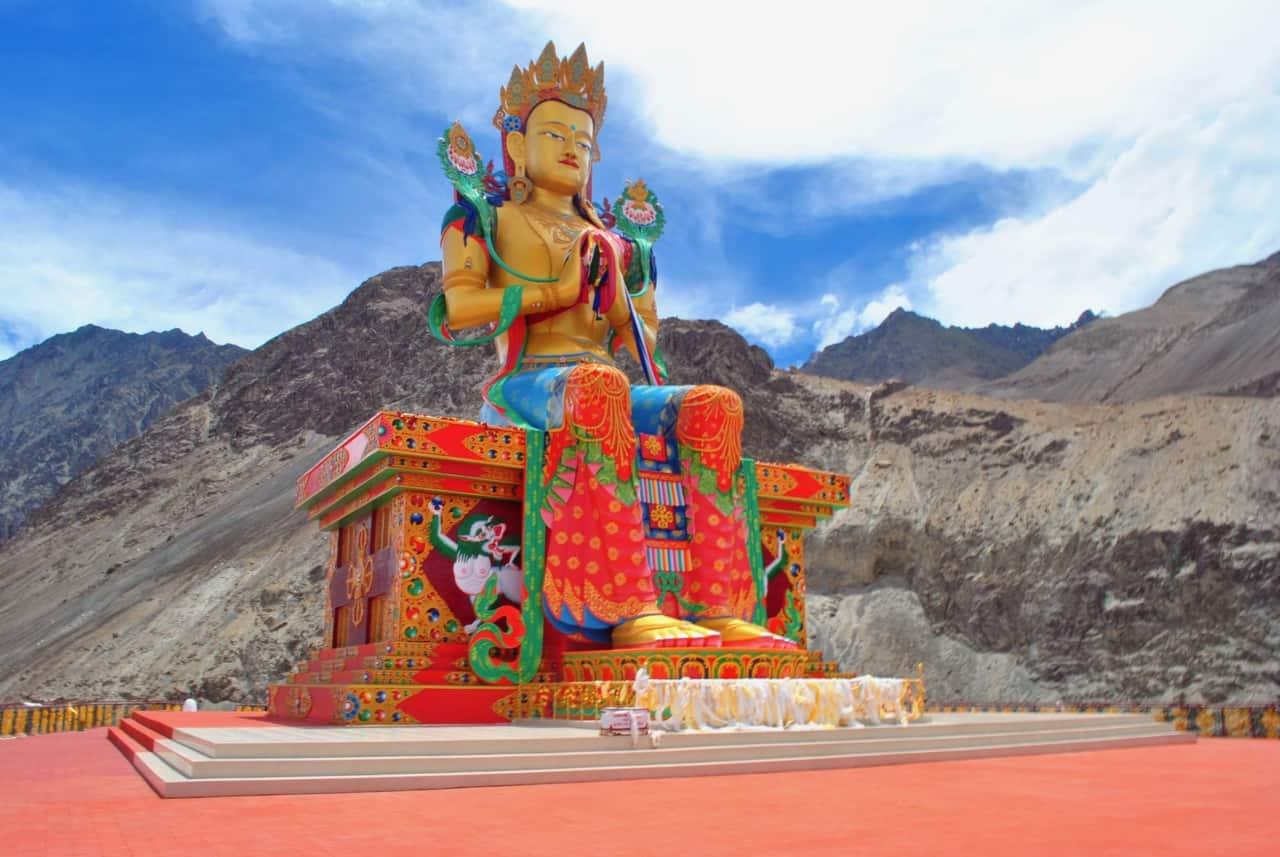In the heart of the Nubra Valley lies a timeless symbol of spiritual serenity and cultural richness—Diskit Monastery. Nestled against the backdrop of stark mountains and the cold desert, this ancient monastery is not just a place of worship but also a living museum of Ladakh’s heritage. For centuries, it has attracted monks, travelers, and spiritual seekers alike, each drawn by its peaceful aura, unique architecture, and awe-inspiring views. The story of Diskit Monastery is one of devotion, survival, and a deep connection to the divine.
A Glimpse into History
Diskit Monastery, also known as Deskit Gompa, is the oldest and largest Buddhist monastery in the Nubra Valley of Ladakh. Founded in the 14th century by Changzem Tserab Zangpo, a disciple of Tsong Khapa, the founder of the Gelugpa sect, the monastery has withstood the test of time and nature. It became a significant center for teaching and meditation in Ladakh, continuing the traditions of Tibetan Buddhism in one of the most isolated parts of India.
Throughout history, this monastery served not just as a religious hub but also as a symbol of peace in the valley. In times of political unrest or invasion, it stood firm like a guardian, sheltering the local culture and spirituality within its ancient walls.
Location and Scenic Grandeur
One of the most breathtaking aspects of Diskit Monastery is its stunning location. Positioned at an altitude of over 10,000 feet, the monastery offers panoramic views of the Nubra Valley and the confluence of the Shyok and Nubra rivers. Reaching the monastery involves crossing the famous Khardung La Pass, one of the highest motorable roads in the world. The journey itself feels like a pilgrimage, as every turn reveals new views of snow-capped peaks, desert sands, and green oases.
As you climb the hill on which the monastery stands, you’re rewarded with a sight that seems suspended in time. The ancient structure, built from stone and wood, clings to the cliffside, harmonizing with the harsh beauty of its surroundings. From the top, the view of the valley is vast and humbling, making the climb worthwhile even for those not spiritually inclined.
Architectural Marvel and Spiritual Significance
Diskit Monastery showcases traditional Tibetan architecture, with its maze-like alleys, wooden balconies, and thick mud-brick walls. The interiors are dimly lit by butter lamps, creating a serene atmosphere filled with the scent of incense and the echo of chanting monks. At its core lies the prayer hall, housing a statue of Maitreya Buddha—the Buddha of the future—alongside ancient scrolls, murals, and scriptures.
One of the monastery’s most iconic features is the 106-foot-tall statue of Maitreya Buddha, which was inaugurated by the Dalai Lama in 2010. This giant statue faces the Shyok River and Pakistan border, symbolizing peace and protection for the region. It serves not only as a religious icon but also as a beacon of hope and harmony for the people of Ladakh.
Cultural Practices and Daily Life
The daily life at Diskit Monastery is a blend of ancient rituals and community involvement. Around a hundred monks reside here, dedicating their lives to prayer, study, and service. They follow the teachings of the Gelugpa school and conduct regular ceremonies that attract both locals and visitors. One of the major highlights is the annual Dosmoche festival, also known as the "Festival of the Scapegoat." Celebrated in February, it features traditional mask dances performed by the monks, symbolizing the victory of good over evil.
Visitors during this time witness the monastery at its most vibrant, with colorful decorations, music, and a palpable sense of celebration. It’s a unique way to experience the deep cultural roots that bind the people of Ladakh to their spiritual institutions.
Diskit Monastery in Modern Times
While Diskit Monastery holds centuries of history, it continues to evolve with time. Efforts have been made to preserve its structure and documents, with support from both local and international bodies. Solar panels and eco-friendly measures have been introduced to sustain the monastery without harming the fragile Himalayan ecosystem.
Moreover, the monastery plays a crucial role in education and social welfare in the Nubra region. It manages a school for underprivileged children, offering them not only secular education but also moral and spiritual guidance rooted in Buddhist philosophy. This initiative highlights the monastery’s role not just as a place of worship but also as a pillar of the community.
Capturing the Monastery: A Visual Delight
For photographers and travelers, Diskit Monastery photos offer a feast for the eyes and soul. From the glowing sunrise over the giant Buddha statue to the snow-covered peaks casting shadows on the gompa’s walls, every frame tells a story of peace and perseverance. The monastery’s raw and majestic appeal has made it a favorite subject for travel bloggers, filmmakers, and spiritual documentarians.
The contrast between the arid desert below and the spiritual sanctum above offers a surreal composition that is difficult to find elsewhere. Whether you’re capturing the intricate details of a monk’s robe or the sweeping landscape of the Nubra Valley, the monastery provides countless perspectives to explore.
Why You Should Visit
Visiting Diskit Monastery is more than just a tourist experience—it’s a journey into a world that thrives on silence, simplicity, and soulfulness. It invites you to disconnect from the chaos of the modern world and immerse yourself in the tranquil rhythm of monastic life. Whether you seek spiritual awakening, historical insight, or simply a moment of reflection amidst nature, the monastery offers a sanctuary unlike any other.
The serene energy that permeates the air, the warm smiles of the monks, and the ancient chants echoing through the halls make you feel part of something eternal. In a fast-moving world, places like Diskit remind us of the value of stillness and the power of faith.
Conclusion
Diskit Monastery Ladakh is not merely a structure perched on a hill—it is a symbol of resilience, devotion, and timeless beauty. Its presence in the barren yet majestic landscape of Nubra Valley reminds us that even in the harshest conditions, spirituality can bloom. For those willing to make the journey, the monastery offers not just a destination but a deep, lasting experience.
Whether you visit for the history, the view, the prayers, or the peace, the memory of Diskit Monastery will stay with you long after the trip ends. It's a place where the past lives on, not just in stone and scripture, but in the hearts of those who come seeking something more.



